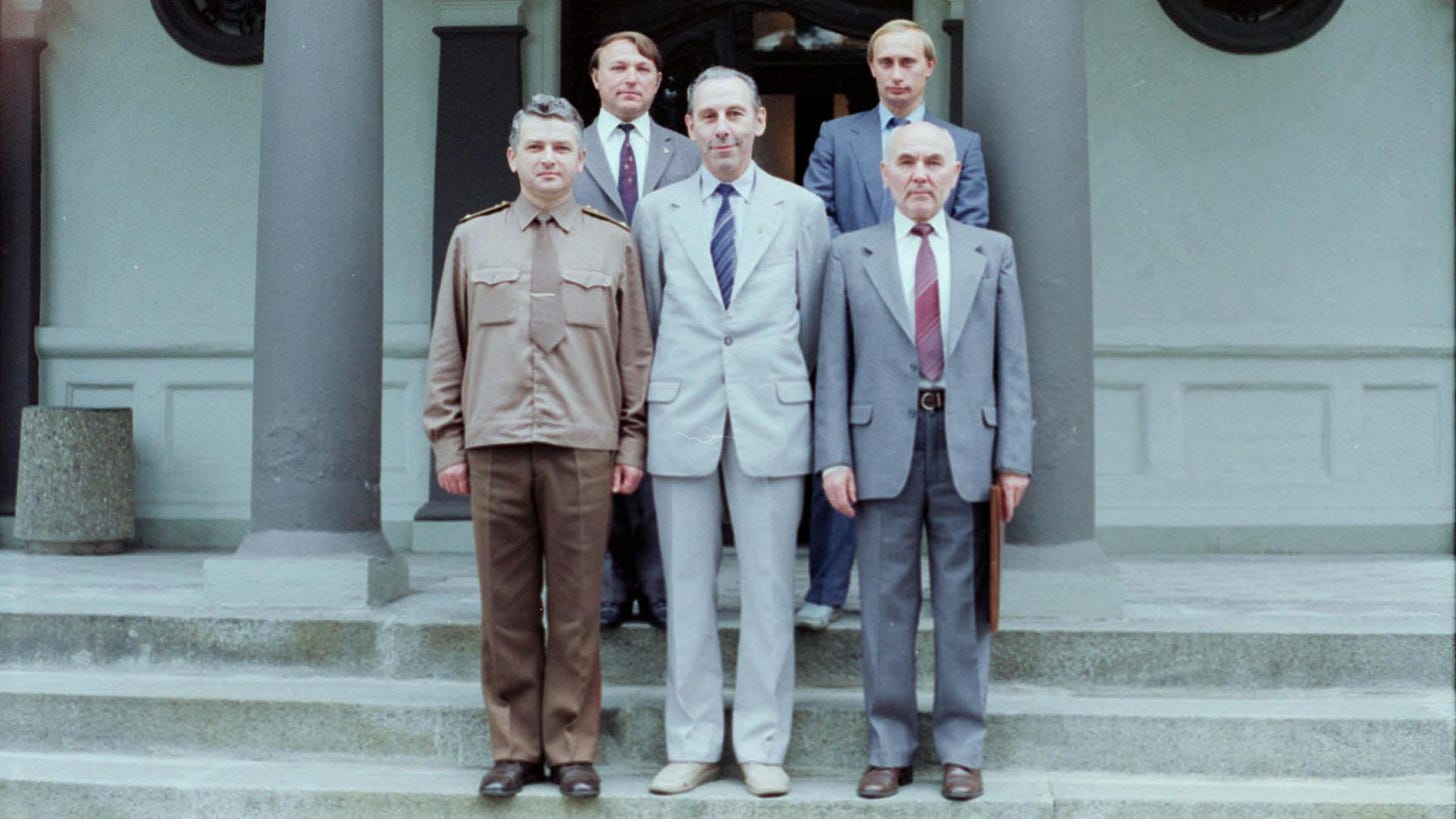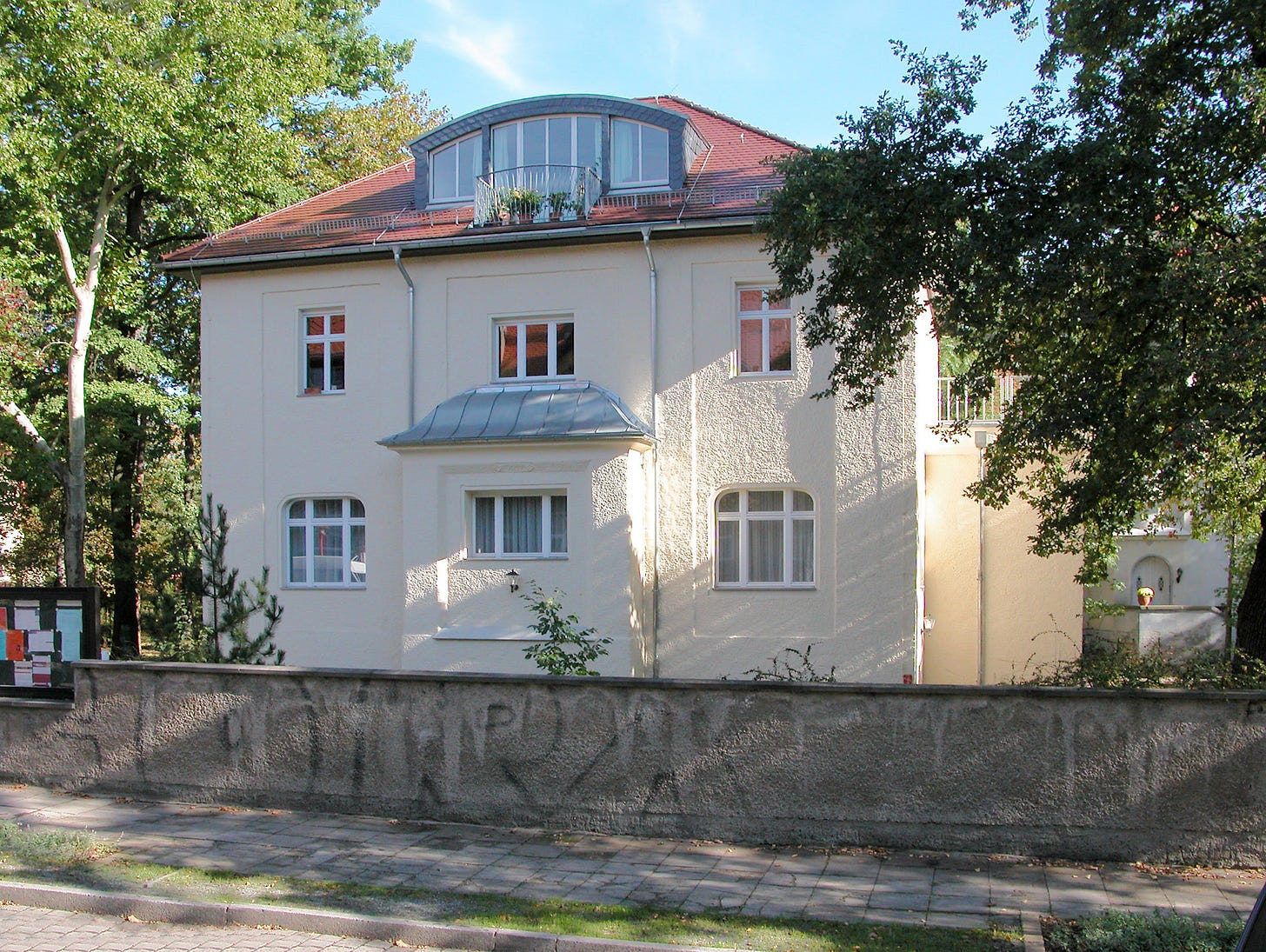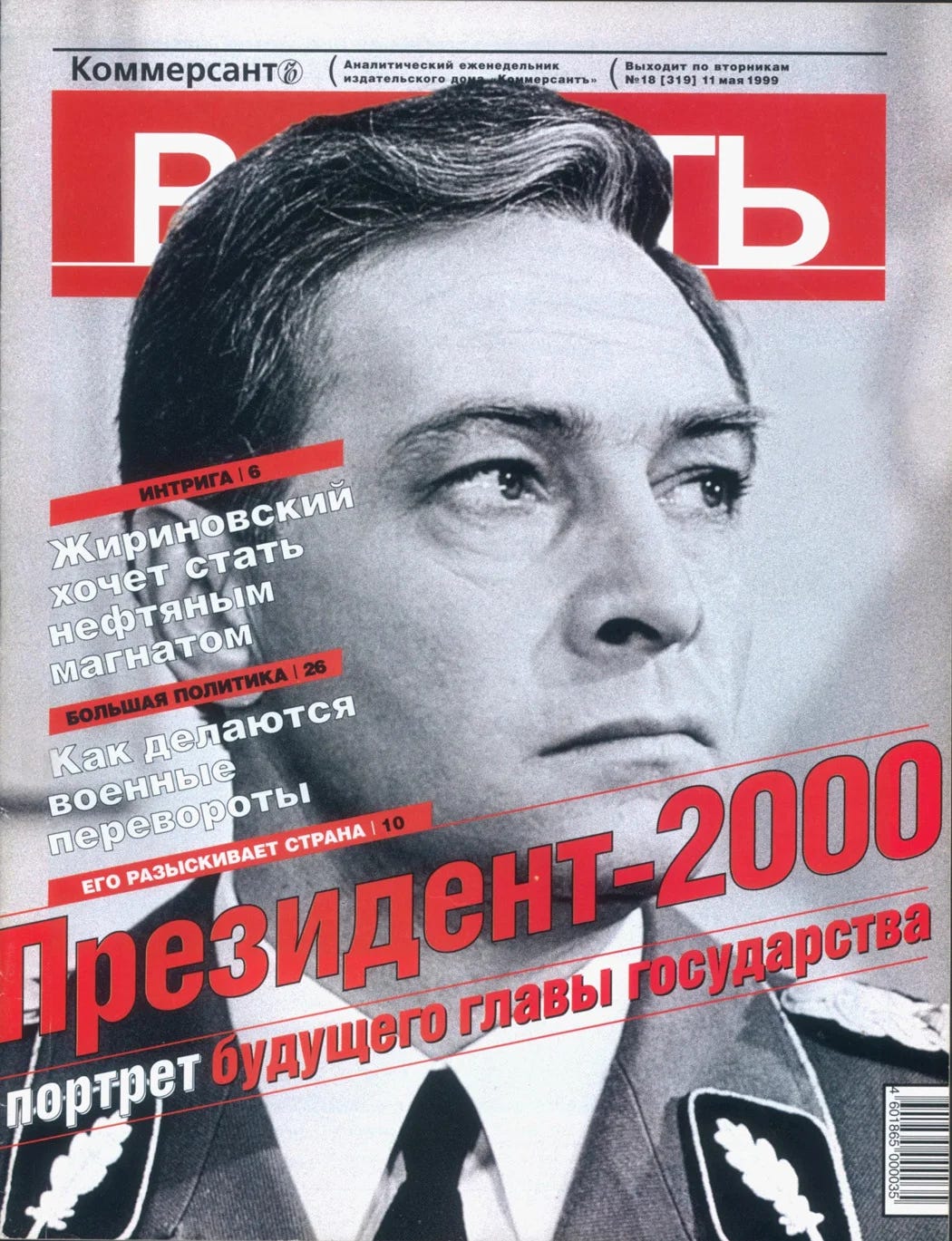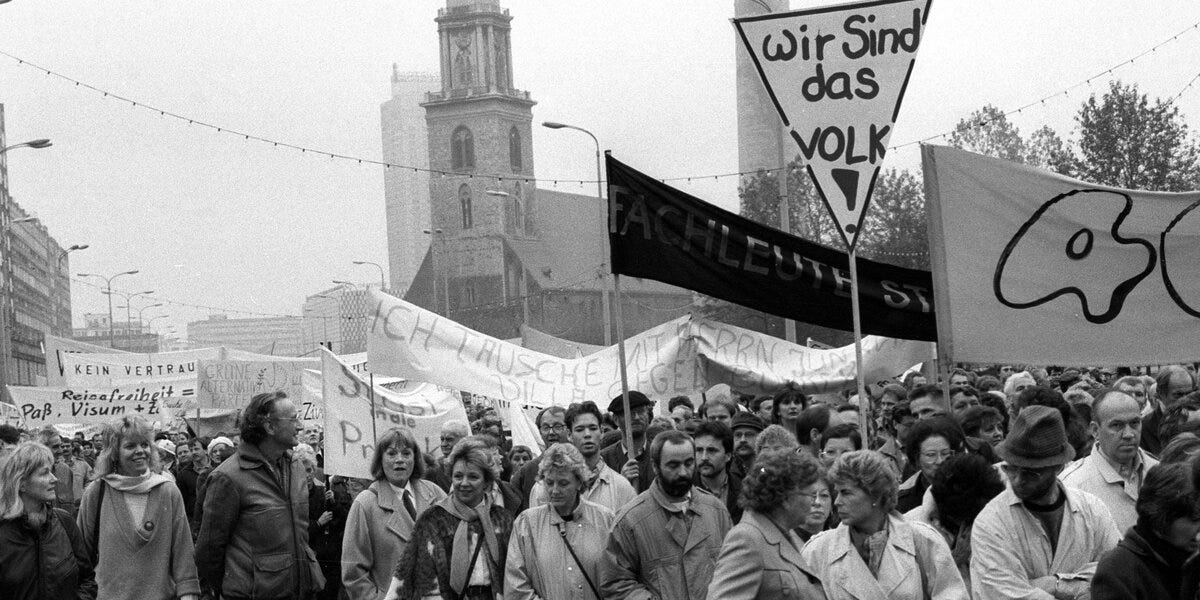This is part two of the essay “Putin’s Genocidal Quest for Symbolic Immortality”. Read part one, Introduction, here.
A wave of revolutions swept across the Eastern Bloc in 1989. Encouraged by democratic breakthroughs in Poland and Hungary, mass protests in the German Democratic Republic (GDR) gained momentum in autumn that year, demanding political reform and freedom of movement. On 9 November, following weeks of unrest, East German authorities unexpectedly announced that citizens would be allowed to travel freely to West Germany and West Berlin. Thousands gathered at the Berlin Wall from both sides, crossing through checkpoints or climbing over it – marking the beginning of its dismantling and the symbolic collapse of the Iron Curtain.
At the time, Vladimir Putin, then a KGB officer in his late 30s, was stationed in Dresden, East Germany. Operating out of the KGB residency located in a villa at Angelikastrasse 4, he apparently managed a network of agents in West Germany from 1985 onward.1 Amid mounting political pressure in East Germany – and following the storming of the Stasi district headquarters in Dresden by pro-democracy demonstrators on 5 December 1989 – the KGB residency in the city was dissolved in February 1990. The same month, Vladimir Putin returned to the Soviet Union.
A decade later, Putin was on the verge of being elected president of Russia for the first time. His campaign leaned heavily on so-called political technologists – specialists who manage and manipulate political processes through strategic communication, media control, propaganda, and electoral tactics to shape public opinion.2 To bolster his image, these technologists began constructing a heroic myth around the final chapter of Putin’s KGB service in Dresden. They built on a historical detail: after protestors stormed the Stasi headquarters in Dresden, a small group of 15-20 German pro-democracy activists made their way to the nearby KGB residency, located just minutes away.
In the mythologised version, this small group became an unruly “mob” of aggressive, predominantly young men determined to break into the KGB villa. Putin, according to the narrative, called the Soviet military command in Dresden to request reinforcements to protect the building and its secrets. The command responded that it could take no action without Moscow’s authorisation and promised to inquire. When Putin telephoned back, they said they had relayed the request but Moscow was silent. In other words, neither the Soviet military command in Dresden nor the central authorities in Moscow were willing, or able, to act.
At that moment, the narrative took on its cinematic tone. Putin stepped outside to confront the crowd. Calmly, he told them that the villa belonged to the Soviet Army and that they were not permitted to enter. He warned that Soviet soldiers inside had orders to open fire if anyone attempted to breach the premises. Then he turned and walked back into the building. Confused and apparently unnerved, the crowd dispersed.3
This narrative about Putin was built on his earlier manufactured image of a modern Russian manifestation of Vsevolod Vladimirov – the fictional Soviet spy who, under the alias Max Otto von Stierlitz, infiltrated Nazi Germany as a high-ranking SS officer during the Second World War. Originally invented by Yulian Semyonov as literary character in the 1960s, Stierlitz became one of the most beloved cult figures in Soviet and, later, Russian popular culture thanks to the 1973 Soviet TV series Seventeen Moments of Spring.

Semyonov’s novel, which inspired the TV series, was commissioned by the KGB chief Yuri Andropov. Both the book and its TV adaptation were part of a propaganda effort to glorify Soviet spies abroad, reshape the KGB’s repressive image, and attract young recruits to a more heroic vision of the secret service.4 The TV series inspired many a young Soviet man to join the KGB’s foreign intelligence service, and Putin was no exception.5 A fan of Stierlitz and other Semyonov’s novels, he joined the KGB in 1975, just two years after the series aired.
In the early 1990s, while Putin was working as an adviser in the St Petersburg mayor’s office following his return from Dresden, a local director made a short documentary about him. In that film, Putin publicly acknowledged, for the first time, his past as a KGB foreign operative. Seizing on this, the director suggested he re-enact a scene from Seventeen Moments of Spring.6
Putin’s early image as a modern-day Stierlitz, though not widely recognised by the public during the 1990s, proved highly useful to the political technologists preparing his presidential campaign in 1999-2000. Humorous public opinion polls at the time showed that Stierlitz ranked among Russians’ favourite fictional candidates for president. One cover of the influential Russian magazine Kommersant even featured, in May 1999, the Soviet TV image of Stierlitz with the caption: “President-2000: a portrait of the future head of state”.7
Putin’s political technologists ensured that, if anyone missed the connection between Putin and Stierlitz, “articles in the press reminded them of the resemblance and helped create the association”.8 By the time of the 2000 presidential election, Putin’s consultants had reinforced the Stierlitz reference by adding the narrative of the Dresden standoff, crafting a seemingly solid and persuasive heroic image: a fearless former spy, capable of calming angry crowds yet unflinching when toughness was required.
There is no independent evidence to verify Putin’s account of the events in Dresden on 5 December 1989,9 but it remains plausible that he witnessed the swelling crowds of German pro-democracy demonstrators in the autumn and early winter of that year. Moreover, the ideas and messages embedded in the narrative about standoff by the KGB residency may offer more insight into Putin’s political thinking than the facts themselves.
“Wir sind das Volk!” – “We are the people!” – was the defining slogan of the democratic revolution in East Germany that Putin witnessed firsthand. In 1989, it was ordinary people who demanded democratic reforms, and it was ordinary Germans who ultimately dismantled the authoritarian GDR. “Wir sind das Volk!” was the slogan of assertion of popular democratic sovereignty.
For a KGB officer representing the interests of the Soviet Union, the slogan and the events behind it – embodying the triumph of the small over the mighty – must have been profoundly unsettling on multiple levels.
The people’s victory over the Party was, above all, a humiliation. The KGB’s central role at home was to maintain repressive control over the population, a role even more ruthlessly fulfilled by its East German counterpart, the Stasi – its younger brother – infamous for the sheer intensity of its domestic surveillance.10 These agencies existed to ensure that people could never claim freedom or sovereignty.
Though the regimes of the Soviet Union, the GDR, and other socialist states claimed to speak for the people, in reality they served only themselves – the Party and the security apparatus. This was the ultimate arrogance of the corrupt socialist elites: to pretend to voice the will of the people while using every instrument of coercion, up to and including physical elimination, to crush it. The Party was the supreme authority; the role of the people was to obey. And it was the secret police that ensured they did.
What happened in Dresden and across the GDR in 1989 was a blunt repudiation of the elitist dogma Putin had been trained to enforce. It was the first victorious “colour revolution” he saw up close – and the first of many he would come to loathe, both for what they reminded him of and for popular democratic sovereignty they stood for.
No less humiliating was the sense of helplessness of the Soviet Union in the face of the 1989 events in East Germany, a country the Soviets regarded as their satellite. Moscow was silent – it could not respond the way that Putin and his fellow secret agents hoped it would, as it did during the East German uprising of 1953, or the Hungarian Revolution of 1956, or the Prague Spring of 1968. As the Soviet Union failed to reinforce its domination over satellites, it was the end of the state for Putin. As he would later recollect, he “had the feeling then that the country was no more. It became clear the Union was sick. It was a deadly, incurable disease called paralysis. A paralysis of power”.11
The Peaceful Revolution in the GDR in 1989 and the broader collapse of Soviet domination were not merely a geopolitical shock, but a deeply personal and existential one for Putin. Even if his career prospects within the system of elitist privilege remained relatively secure, for a KGB officer trained to subordinate himself entirely to the state – to live for and through it – the state’s deadly paralysis marked a profound identity crisis.

It was not just the Soviet system that was unravelling; so was the very foundation of Putin’s sense of self. In 2005, he described the collapse of the Soviet Union as “the greatest geopolitical catastrophe” of the 20th century, and urged the Russian elite to “acknowledge” this loss.12 And while many did share his view of the collapse as a national tragedy, for Putin it was, above all, a deeply personal trauma.
It is natural for humans – as the species uniquely capable of understanding the inevitability of death – to seek ways of reconciling the instinct for self-preservation with the knowledge of mortality by identifying with entities greater and more enduring than the individual self: family, communities of faith, nation, state. These collective identities offer a sense of continuity that transcends a single human life, by shielding “ourselves from the devastating awareness of our underlying helplessness and the terror of our inevitable death”.13
We imagine that we will not truly die when our time comes if we believe our soul will continue to live after departing its mortal sheath. Or we imagine that, if we have descendants, we will live through them – they will preserve our memory, just as we honour our ancestors. Alternatively, we may envision ourselves living on through a collective which we conceive as our nation or our state: by contributing to its prosperity and grandeur, we gain the hope of inclusion in its cultural memory – a form of eternal fame.14
What results from these beliefs is that the more we trust these cultural strategies to evade death, the deeper we internalise them, the less tolerant we become of those perceived as threatening the collective identities we associate ourselves with.15 When it comes to protecting offspring, it is a natural instinct found across much of the animal kingdom – humans included – and in humans, it is generally amplified by culture. Defence of one’s nation, religion, or state is predominantly cultural, but is often no less fierce than in the case of protecting one’s next generation, where evolutionary instincts are reinforced by cultural conventions. The reason for this is that we do not defend an abstract identity, national or religious – rather, we defend our pathway to symbolic immortality.
The perceived deadly sickness of the Soviet Union, followed by its dissolution, was not only a geopolitical rupture but also a blow to Putin’s psychological armour that had shielded him from existential dread by promising survival through the Soviet state.
The exact opposite of symbolic immortality is oblivion. Three decades after the Soviet collapse, Putin would draw a direct parallel between the paralysis of power and oblivion, thus indirectly associating the survival of the state with symbolic immortality: “In the late 1980s, the Soviet Union grew weaker and subsequently broke apart. That experience [...] has shown us that the paralysis of power and will is the first step towards complete degradation and oblivion”.16
However, the Soviet Union did not simply “grow weaker” and “break apart”. The blow to Putin’s psychological armour came from the West: it was the West that emerged victorious from the Cold War, which ended with the collapse of the Soviet Union. Yet the West, while the primary source of this geopolitical trauma, was not the only one. It was also the ordinary people and their pursuit of popular democratic sovereignty who dismantled and humiliated the foundations of the repressive state – and, in doing so, shattered the very structure that had held that psychological armour together.
The underlying logic of popadanstvo is that once a specific historical turning point is identified as detrimental to Russia – whether as the Russian Empire or the Soviet Union – a protagonist can travel back in time to change it and thereby “correct” the present. Over time, Putin appeared to have gradually embraced the idea that alternative history could be transformed into political reality.
Continue reading: Part Three, “His-story of Ukraine”
David Crawford, Marcus Bensmann, “Putins frühe Jahre”, Correctiv, 30 July (2015), https://correctiv.org/aktuelles/korruption/system-putin/2015/07/30/putins-fruehe-jahre/.
Andrew Wilson, Political Technology: The Globalisation of Political Manipulation (Cambridge: Cambridge University Press, 2024).
Ot pervogo litsa. Razgovory s Vladimirom Putinym (Moscow: Vagrius, 2000), pp. 71-72; Steven Lee Myers, The New Tsar: The Rise and Reign of Vladimir Putin (New York: Vintage Books, 2016).
Arkady Ostrovsky, The Invention of Russia: The Rise of Putin and the Age of Fake News (New York: Penguin Books, 2017), p. 230; Phillip Knightley, The Second Oldest Profession: Spies and Spying in the Twentieth Century (London: Pimlico, 2003), p. 368.
In 2019, referring to a conversation with someone in the Russian Presidential Administration, Semyonov’s daughter, Olga Semyonova, said that Seventeen Moments of Spring was Putin’s favourite novel, see “Doch' Yuliana Semyonova Olga o vospitanii ‘po Shtitlitsu’ i lyubimom geroe Putina”, Sputnik Belarus, 22 May (2019), https://sputnik.by/20190522/Doch-Yuliana-Semenova-vospitanii-po-Shtirlitsu-i-lyubimom-geroe-Putina-1041261512.html.
“Romantik iz razvedki: v Peterburge vspomnili pervoe poyavlenie Putina na TV”, NTV, 27 March (2007), https://www.ntv.ru/novosti/106187/.
Kirill Fokin, “A vas, Shtirlits, ya poproshu vmeshat’sya”, Novaya gazeta Evropa, 11 August (2023), https://novayagazeta.eu/articles/2023/08/11/a-vas-shtirlits-ia-poproshu-vmeshatsia; see also “Chetyre portreta prezidenta-2000”, Kommersant, 11 May (1999), https://www.kommersant.ru/doc/15481.
Ivan Zassoursky, Media and Power in Post-Soviet Russia (Armonk: ME Sharpe, 2004), pp. 132-134.
A research report on the occupation of the Stasi district administration in Dresden and the period afterwards does not confirm Putin’s involvement in the standoff by the KGB residency on 5 December 1989, see Ilona Rau, “Besetzung der Dresdener Bezirksverwaltung und die Zeit danach – ein Recherchebericht”, StasiBesetzung, https://stasibesetzung.de/dresden/default-title.
The 2006 German drama film The Lives of Others (Das Leben der Anderen) directed by Florian Henckel von Donnersmarck provides an excellent glimpse into the horror of the Stasi surveillance in East Germany.
Ot pervogo litsa, pp. 71-72.
“Annual Address to the Federal Assembly of the Russian Federation”, President of Russia, 25 April (2005), http://en.kremlin.ru/events/president/transcripts/22931.
“The Heroics of Everyday Life: A Theorist of Death Confronts His Own End. A Conversation with Ernest Becker by Sam Keen”, Psychology Today, Vol. 7 (1974), pp. 71-80 (71). See also Ernest Becker, The Denial of Death (New York: Free Press, 1973).
See Sheldon Solomon, Jeff Greenberg, Thomas A. Pyszczynski, The Worm at the Core: On the Role of Death in Life (London: Penguin Books, 2016).
Holly A. McGregor, Jeff Greenberg, Jamie Arndt, Joel D. Lieberman, Sheldon Solomon, Linda Simon, Tom Pyszczynski, “Terror Management and Aggression: Evidence that Mortality Salience Motivates Aggression against Worldview-Threatening Others”, Journal of Personality and Social Psychology, Vol. 74, No. 3 (1998), pp. 590-605.
“Address by the President of the Russian Federation”, President of Russia, 24 February (2022), http://en.kremlin.ru/events/president/news/67843.






